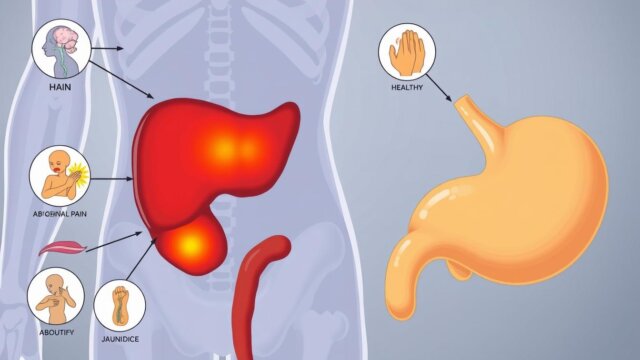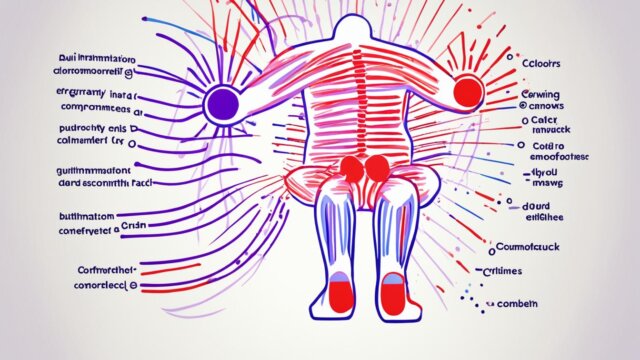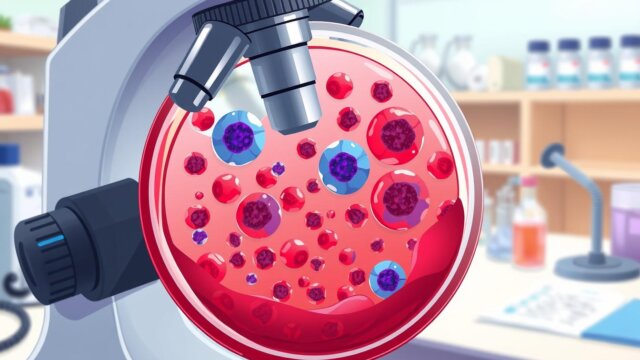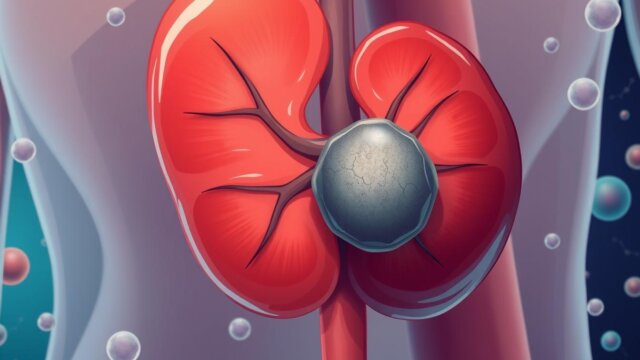FTC disclaimer: This post may contains affiliate links and we will be compensated if you click on a link and make a purchase.
Merkel cell carcinoma (MCC) is a rare and aggressive skin cancer. It affects about 2,000 to 3,000 people in the United States each year. This cancer often shows up as a painless, flesh-colored or bluish-red nodule on the skin. It usually appears in sun-exposed areas like the face, neck, arms, and legs.
Even though Merkel cell cancer is small, usually between 1-5 cm in diameter, it can spread quickly. This makes early detection and treatment very important.
Key Takeaways
- Merkel cell carcinoma is a rare and aggressive form of skin cancer.
- It often appears as a painless, flesh-colored, or bluish-red nodule on sun-exposed skin.
- Merkel cell tumors are typically small but can spread quickly to other parts of the body.
- Early detection and treatment are critical for managing Merkel cell carcinoma.
- Treatment options may include surgery, radiation therapy, chemotherapy, and immunotherapy.
What is Merkel Cell Cancer?
Merkel cell carcinoma is a rare and aggressive skin cancer. It grows fast and spreads quickly. It often shows up as a flesh-colored or bluish-red nodule, usually on the face, head, or neck.
Rare and Aggressive Skin Cancer
This cancer is very rare and is the second most common cause of skin cancer death after melanoma. It’s more common in older people, especially those over 50. Too much sun, a weak immune system, other skin cancers, and light skin color can raise your risk.
Develops from Merkel Cells in the Epidermis
Merkel cell carcinoma comes from Merkel cells in the skin’s outer layer, the epidermis. These cells help us feel touch. A virus called Merkel cell polyomavirus often causes this cancer.
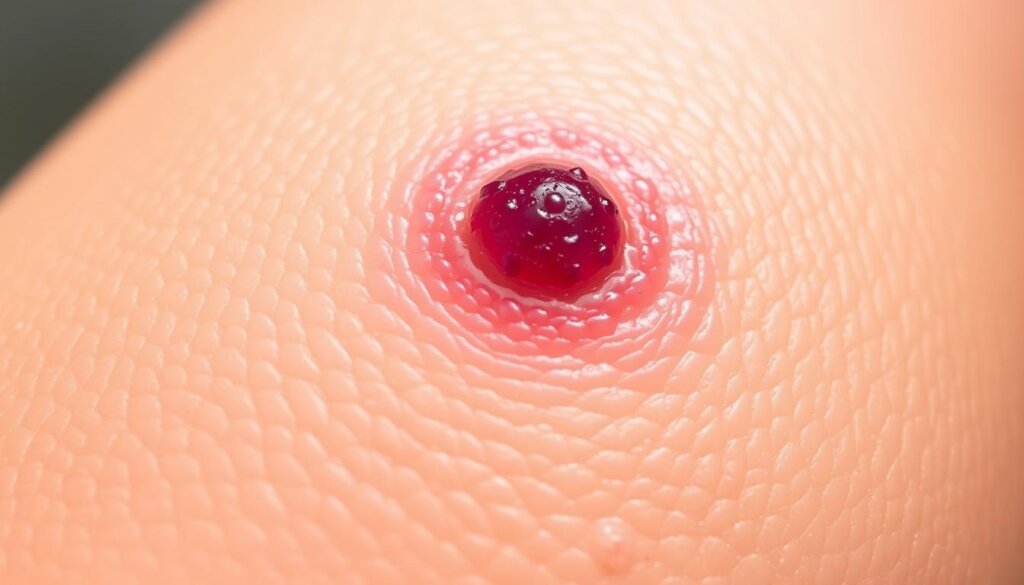
This cancer is very aggressive and can spread fast. It often goes to nearby lymph nodes and other organs. Even with treatment, it often keeps spreading. This shows why finding it early and treating it quickly is so important.
Key Characteristics of Merkel Cell Carcinoma | Details |
|---|---|
Rarity | Merkel cell carcinoma is a very rare disease, and it is the second most common cause of skin cancer death after melanoma. |
Aggressiveness | Merkel cell carcinoma is an aggressive form of skin cancer that can spread rapidly beyond the skin, often metastasizing to nearby lymph nodes and other organs. |
Risk Factors | Risk factors for Merkel cell carcinoma include being exposed to natural sunlight or artificial sunlight, having a weakened immune system, having a history of other types of cancer, and being older than 50 years, male, or White. |
Appearance | Merkel cell carcinoma usually appears on sun-exposed skin as a single lump that is fast-growing, painless, firm, dome-shaped or raised, and red or violet in color. |
Spread | After Merkel cell carcinoma has been diagnosed, tests are done to find out if cancer cells have spread to other parts of the body. |
In summary, Merkel cell carcinoma is a rare and aggressive skin cancer. It grows fast and can be deadly. Early detection and quick treatment are key.
Symptoms of Merkel Cell Cancer
Merkel cell carcinoma is a rare and aggressive skin cancer. It often shows up as a fast-growing, painless skin nodule or bump. These bumps can be flesh-colored, bluish-red, or purple.
This cancer usually appears on sun-exposed areas like the face and neck. But it can also show up in areas not often in the sun. The skin lesions can look different, but they often feel firm and shiny.
Research shows Merkel cell carcinoma can affect anyone, not just older, fair-skinned people. It can also hit younger adults and those with darker skin. In African Americans, it often appears on the leg. Younger people tend to get it on their torso.
This cancer grows fast. The skin lesions can grow quickly, sometimes in just weeks or months. While they’re usually painless, some people might feel sore, tender, or itchy.
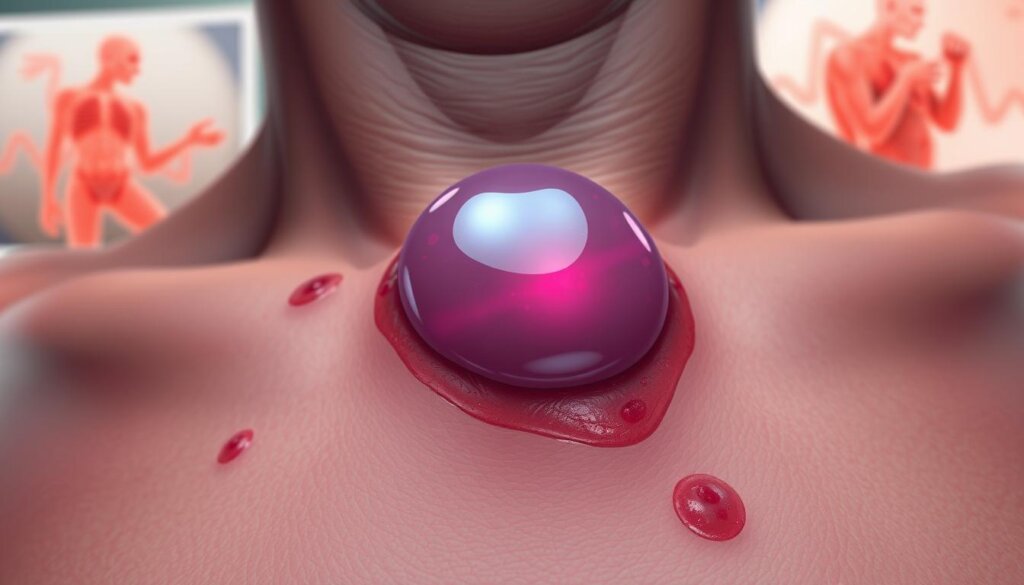
It’s key to catch Merkel cell carcinoma early for effective treatment. This cancer can spread fast to other parts of the body. If you see any unusual skin growths or changes, see a dermatologist or healthcare professional for a check-up.
Causes and Risk Factors
The exact cause of Merkel cell carcinoma (MCC) is still a mystery. But, researchers have found several key risk factors. These factors make it more likely to get this rare and aggressive skin cancer.
Merkel Cell Polyomavirus Infection
One big risk factor is infection with Merkel cell polyomavirus (MCV). About 80% of MCC patients have had MCV before. This shows a strong connection between the virus and MCC.
Excessive UV Exposure and Sun Damage
Being in the sun or using tanning beds is a major risk for MCC. UV rays can damage DNA and lead to mutations. This is especially true for people with light skin.
Weakened Immune System
A weak immune system also raises MCC risk. People with HIV/AIDS, certain lymphomas, or those on immunosuppressive drugs are at higher risk. Their bodies can’t fight off infections and cancer well.
Knowing these risk factors helps prevent MCC. Stay safe in the sun, keep your immune system strong, and watch for skin changes.

Merkel Cell Cancer Diagnosis
Diagnosing Merkel cell carcinoma starts with a skin check and a biopsy of the growth. A skin biopsy removes a small tissue sample for microscope analysis. Tests like CT scans and PET scans help see if the cancer has spread.
Dermatologists first look at the skin with a special tool called a dermatoscope. If it looks bad, a biopsy is done. The type of biopsy depends on the tumor’s size and where it is.
After the biopsy, tests like immunohistochemistry confirm the diagnosis. These tests also give important info about the cancer. A sentinel lymph node biopsy checks if the cancer has spread to nearby lymph nodes.
Knowing how Merkel cell carcinoma is diagnosed is key for early treatment. With 3,000 new cases in the U.S. each year, it’s vital to watch for skin changes.
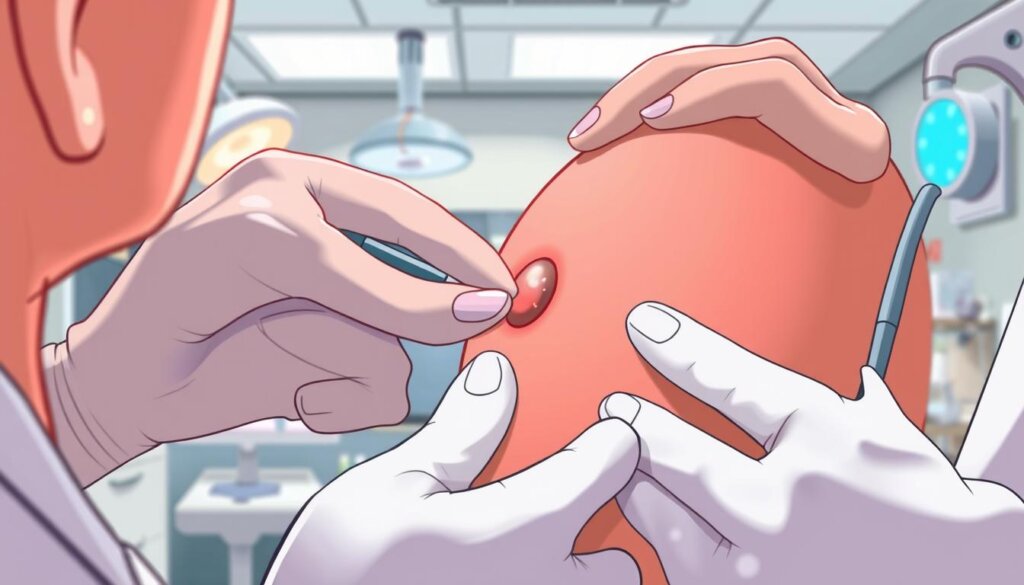
Staging of Merkel Cell Cancer
After finding Merkel cell carcinoma, doctors will check how far it has spread. This helps decide the best treatment. They look at the tumor size, if it’s in lymph nodes, and if it’s in other parts of the body.
The cancer’s stage is based on T (tumor size), N (lymph nodes), and M (distant sites). Higher numbers mean more advanced cancer. They use a stage grouping method to find the overall stage.
The pathologic stage is based on tissue tests. The clinical stage uses exams and scans. But, the clinical stage might not always show how far the cancer will go.
Stage | Description |
|---|---|
Stage 0 (Tis) | Cancer is only in the epidermis, the outermost skin layer, and has not spread to nearby lymph nodes or distant sites. |
Stage I (T1) | Cancer is no more than 2 centimeters (cm) across and has not spread to nearby lymph nodes or distant sites. |
Stage IIIA | Cancer can be any size and may have grown into nearby tissues. It has spread to nearby lymph nodes but has not reached distant sites. |
Stage IV | Cancer can be any size, and it may or may not have spread to nearby lymph nodes. It has spread to distant lymph nodes or organs like the lungs or skin. |
Merkel cell carcinoma is rare, affecting less than 1 in 100,000 people yearly. In the U.S., about 3,500 people get it each year. If caught early, the survival rate is 75%. If it spreads, it’s 64%, and to distant sites, it’s 24%.
Treatment Options for Merkel Cell Cancer
Merkel cell carcinoma (MCC) is a rare and aggressive skin cancer. It needs special treatment. Dermatologists suggest a team of experts for care. This team includes surgical, radiation, and medical oncologists.
Surgical Removal of Tumor
The main treatment for MCC is removing the tumor. This is called a wide local excision. It removes the tumor and some healthy tissue around it. Sometimes, they also check lymph nodes for cancer spread.
Radiation Therapy
Radiation therapy is used with surgery to kill more cancer cells. It’s good for big tumors or cancer in lymph nodes.
Chemotherapy
Chemotherapy is for advanced MCC. It tries to shrink the tumor and ease symptoms. But, it’s only temporary.
Immunotherapy
Immunotherapy is a new hope for MCC. A study showed avelumab helped one-third of advanced MCC patients. They responded for about 10 months. Avelumab is the first FDA-approved drug for stage IV MCC.
The treatment plan for Merkel cell cancer varies. It depends on the disease stage and the patient’s health. A team of specialists is key for the best care.
Treatment Option | Description |
|---|---|
Surgical Removal | Wide local excision to remove the entire tumor and surrounding healthy tissue |
Radiation Therapy | Used in combination with surgery to target remaining cancer cells and reduce recurrence risk |
Chemotherapy | Recommended for advanced or metastatic MCC to shrink the tumor and alleviate symptoms |
Immunotherapy | Emerging treatment option, with avelumab being the first FDA-approved drug for advanced MCC |
Merkel cell carcinoma treatment needs a team effort for the best results.
Prognosis and Survival Rates
Merkel cell carcinoma is a fast-growing skin cancer. The prognosis depends on the cancer’s stage. Early-stage Merkel cell carcinoma has a better chance of survival, with a 5-year survival rate of around 60-80%. But, if the cancer spreads, the 5-year survival rate falls to about 25%.
Recent studies have given us more information about Merkel cell cancer survival rates. A Canadian study found that the 5-year survival rates were 49.8% for stage I, 39.8% for stage II, 36.2% for stage III, and 18.5% for stage IV. Patients who got surgery and radiotherapy had the best 5-year survival rate at 49.9%.
While these numbers give a general idea, remember that each person’s outcome can differ. It’s possible for the cancer to come back, but catching it early can help with treatment. New treatments that target hormone-producing cells and use the immune system also look promising for a better Merkel cell cancer prognosis.
Stage | 5-Year Survival Rate |
|---|---|
Localized Merkel Cell Carcinoma | 78% |
Merkel Cell Carcinoma with Lymph Node Involvement | 52% |
Remember, these survival rates are based on many people and might not predict what will happen to you. Regular check-ups and quick treatment are key to managing Merkel cell cancer and improving your chances of a good outcome.
Preventing Merkel Cell Cancer
Merkel cell carcinoma (MCC) is a rare skin cancer. But, you can lower your risk by avoiding UV radiation. Use sun safety measures to protect your skin from UV rays. Also, stay away from tanning beds and sunlamps to prevent skin damage and cancer.
Limit UV Exposure
Reducing UV radiation exposure is key to preventing MCC. Stay in the shade when the sun is strongest. Wear long sleeves, pants, and a wide-brimmed hat. Use a broad-spectrum sunscreen with SPF 30 or higher and reapply every two hours.
Use Sunscreen Regularly
Using sunscreen often is vital to prevent MCC and other skin cancers. Pick a sunscreen that blocks UVA and UVB rays. Apply it to all skin that’s exposed. Reapply every two hours, or more if you swim or sweat.
By limiting UV exposure and using sunscreen, you can lower your MCC risk. Prevention is crucial for this aggressive skin cancer.
Living with Merkel Cell Cancer
Living with Merkel cell carcinoma is tough, both in body and mind. Regular check-ups and working with your healthcare team are key. They help manage your treatment, watch for signs of cancer coming back, and deal with side effects.
Getting support from loved ones or groups is also very helpful. Merkel cell carcinoma can really affect your feelings, making you worry and feel scared.
- Follow-up for Merkel Cell Carcinoma (MCC) might include exams every 3 to 6 months for the first 3 years. Then, every 6 or 12 months after.
- Those at higher risk, like those with big tumors, might need tests like PET/CT scans.
- Checking your skin and lymph nodes monthly is recommended for MCC patients.
- MCC can come back within the first couple of years or even years later.
A good survivorship care plan for MCC patients includes follow-up exams and tests. It also talks about long-term side effects, diet, and staying active. Remember to keep your health insurance to cover these important tests and visits.
Metric | Merkel Cell Carcinoma | Melanoma |
|---|---|---|
Mortality Rate | About 1 in 3 patients | About 1 in 9 patients |
Radiation Treatment | 25 rounds with a 2-week break due to burns | N/A |
Current Status | 6 months cancer-free | N/A |
“I had 25 rounds of radiation treatment. I had to stop for a two-week break because I had gotten such severe burns on my neck.” – Jepson, Merkel Cell Cancer Survivor
There’s no proven diet to stop MCC from getting worse or coming back. But, a healthy lifestyle, like eating well and staying active, is good.
Getting emotional support is key to handling the anxiety or depression that comes with cancer. There are many support options, like groups, counseling, and therapy.
By working with your healthcare team, getting emotional support, and staying healthy, you can face the challenges of Merkel cell cancer. This way, you can focus on your cancer survivorship.
Conclusion
Merkel cell carcinoma is a rare and aggressive skin cancer that needs quick diagnosis and full treatment to help patients. Knowing how this disease works, like its link to Merkel cell polyomavirus, is key for doctors and patients. Learning about its signs, risks, and treatments helps you find it early and get the right care.
Even though Merkel cell carcinoma is tough, new research and treatments give hope for better lives. Knowing about this cancer and how to prevent it helps you make smart health choices. By being careful and getting help fast, you can help find and treat Merkel cell carcinoma well.
In short, Merkel cell carcinoma is a complex area of cancer research, and we need more studies and learning to help those with it. By staying up-to-date and active, you can lower your risk and get the care you need. This can lead to a better life and a positive outlook.
FAQ
What is Merkel cell carcinoma?
Merkel cell carcinoma is a rare and aggressive skin cancer. It comes from Merkel cells in the skin’s outer layer. It’s also called neuroendocrine carcinoma of the skin or trabecular cancer.
What are the symptoms of Merkel cell carcinoma?
The first sign is a fast-growing, painless nodule on the skin. It might be flesh-colored, bluish-red, or purple. These tumors often appear on the face, head, or neck.
What causes Merkel cell carcinoma?
The exact cause is not known. However, risk factors include Merkel cell polyomavirus infection. Also, too much sun or tanning bed use and a weak immune system are factors.
How is Merkel cell carcinoma diagnosed?
A skin biopsy is used to diagnose it. A small sample is taken and checked under a microscope. CT scans or PET scans might also be used to see if it has spread.
How is Merkel cell carcinoma staged?
After diagnosis, the cancer is staged. This tells how far it has spread. The stage helps decide the best treatment plan.
What are the treatment options for Merkel cell carcinoma?
Treatment often includes surgery, radiation, chemotherapy, and immunotherapy. The plan depends on the cancer’s stage and spread.
What is the prognosis for Merkel cell carcinoma?
Merkel cell carcinoma is aggressive. Early stages have a better prognosis. But, if it spreads, survival rates drop significantly.
How can Merkel cell carcinoma be prevented?
Preventing it is hard, but reducing UV exposure helps. Wear protective clothing, seek shade, and use sunscreen with SPF 30 or higher.
What is it like to live with Merkel cell carcinoma?
Living with it is tough, physically and emotionally. Work with your healthcare team and seek support from loved ones or groups.


